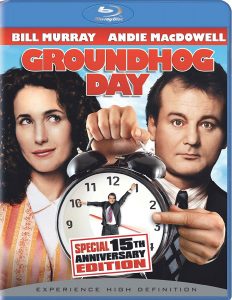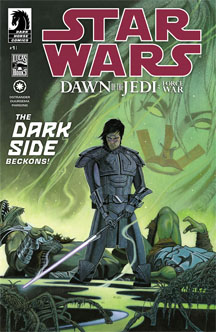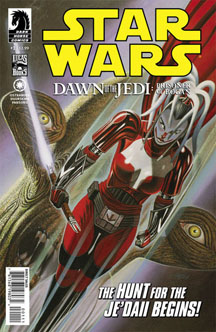Wrapping up their “Dawn of the Jedi” trilogy, writer John Ostrander and artist/co-writer Jan Duursema deliver a strong character piece with the five-issue “Prisoner of Bogan” (2012-13) and an epic conclusion with the five-issue “Force War” (2013-14).
As with a lot of trilogies, part two is the meatiest, as we meet Daegen Lok, who – despite being the hero of the recently concluded civil war in the Tython System — had been exiled to the moon of Bogan for skewing too close to the dark side. He and the newly exiled Xesh team up, find a ship that Xesh can operate using the Force, and flee to various planets in the system as Je’daii journeyers and masters pursue them.
Despite being a dark-sider, Xesh is sympathetic because the dark side is all he’s ever known. It’s like if a kidnapped child emerged from a cellar after a decade: We wouldn’t expect him to understand cultural norms. As we see in flashbacks, the only positive part of Xesh’s upbringing as a Rakatan slave is his bond with fellow human Force hound Trill. But he makes an enemy of her by declining to kill her in a battle, humiliating her by sparing her life.
Additionally, Xesh has lost the memory of the specifics of his time before crash-landing on Tython, so he doesn’t realize how evil he’s supposed to be – kind of like the “TMNT” episode “Cowabunga, Shredhead,” where Shredder acts like Michaelangelo for a day.
I also sympathize with Lok, because being banished to Bogan doesn’t seem like fair treatment for a hero because he tapped into the dark side a bit and saw a vision of a dark future in the Chasm. Furthermore, wouldn’t it make more sense to banish dark-side users to Ashla rather than Bogan? Even if the concept of Ashla being the light-side moon and Bogan being the dark-side moon is purely metaphorical, psychology tells us that sunlight inspires a positive mood and darkness inspires a negative mood. And indeed, Lok has used his time on Bogan to perfect his dark-side trick of making his enemies experience their worst fears. What’s more, Je’daii Ranger Hawk Ryo – who had the same vision as Lok in the Chasm – used his time on Bogan to bury the truth of the vision in order to please his masters.
My feelings toward the Je’daii masters on Tython are in line with how I feel about the Jedi Order during the Clone Wars: I suppose they mean well, but their adherence to tradition too often blinds them to common sense.
“Prisoner of Bogan” concludes with the Rakatan Infinite Empire learning Tython’s location from Trill, and “Force War” throws us smack-dab in the middle of the titular war. The leap forward in time between parts two and three seems out of character for Ostrander and Duursema, based on their meticulous story crafting in “Republic” and “Legacy.” The truce between the Je’daii leadership and Xesh and Lok happens off-panel, and other truncated concepts include a romance between Trill and Sek’nos Rath and more details about the nature of the conflict in the Despot War, of which Lok was the hero. I suspect Ostrander and Duursema opted to wrap up “Dawn” in just three miniseries due to the rumored shift of the license from Dark Horse to Marvel.


As far as war stories go, “Force War” is suitably epic, as the vicious Rakata – who eat their enemies, sometimes while they’re still alive – employ mutant monster forms of themselves, called Flesh Raiders, on the battlefield. They also use the life forces of captives, trapped in bubbles, to power their spaceships.
Predor Skal’nas becomes obsessed with finding the Infinity Gate – much as Dalien Brock was in the novel “Dawn of the Jedi: Into the Void,” set roughly concurrently with the first comic arc, “Force Storm.” The Infinity Gate is a leftover piece of technology from the Kwa, earlier Tython settlers who inadvertently unleashed the evil Rakata on the galaxy as part of their humanitarian mission to open up hyperspace gates between worlds. Unlike the standard Kwa hyperspace gate, the Infinity Gate doesn’t require a complementary gate at the other end, so it’s the ultimate “key to galactic dominance” maguffin.
By the end of “Force War,” there’s room for more exploration of Lok’s dark nature and his conflict with the Je’daii establishment. They want him to destroy his Forcesaber, which is powered by the dark side; he believes he still needs it to clean up stray Flesh Raiders.
Indeed, despite the defeat of the Infinite Empire, the “Dawn of the Jedi” saga leaves some meaty ideas on the table. While it’s possible that the authors intended to leave the Tho Yor (the nine pyramid ships that deposited various Force users on Tython a millennium ago) mysterious, I suspect they might’ve delved more into them if the series had continued.
And since “Dawn” was intended to show the formation of what became the modern Jedi Order, future stories probably would’ve explored the development of lightsabers that don’t require the dark side, plus central Jedi tenets such as the banning of romantic attachments.
Still, considering the outside commercial forces driving this saga, I have to admit Ostrander and Duursema wrap it up in a fairly tidy bow with “Force War.”

